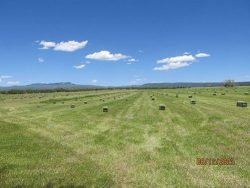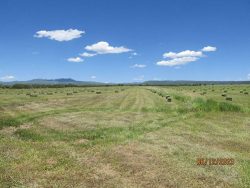The plants and animals we as Farmers and Ranchers raise depend on adequate trace elements to survive the variations of weather, and deficiencies and excesses of the soil profile. Most Conventional Farmers/Ranchers are concerned about N.P.K. (nitrogen-phosphorus potassium) and not so much concerned about the other needed elements.
In the book Ideal Soil V 2.0, a Handbook for the New Agriculture. (acresusa.com) the following amounts are, Calcium to Magnesium ratio should be Calcium 68%, Magnesium 12% equaling 80% of all the general elements we work with in all of our soil sample analysis. Generally, these two elements are not even thought about. The following elements are the minimums per acre that should be in our soil so that the "active biology" can pass these on to the plant. CALCIUM-1500 lbs per acre, MAGNESIUM-200 lbs per acre, POTASSIUM-200 lbs per acre, SODIUM-50 lbs per acre, PHOSPHOURS-200 lbs per acre, SULFUR-100 lbs per acre, IRON- 100 lbs per acre, MANGANESE-50 lbs per acre, ZINC-20 lbs per acre, COPPER- 10 lbs per acre, BORON-2 lbs per acre.

The following are some of the many activities that the elements provide for the nutrition and health of the plant. NITROGEN (N) Stimulates plant growth, instrumental in chlorophyll development, protein production as well as enzymes. PHOSPHOURS (P) Important for root development, plant growth, photosynthesis, protein development, and fruit formation-to name a few. POTASSIUM (K) Helps create carbohydrates-sugars, proteins, important for many of the reproductive phases of the plant’s growth and through maturity. CALCIUM (Ca) Requires the uptake of nitrogen and other minerals, needed to create cell structures and cell divisions in the plants stems and leaves, important for water movement in the plant. The plant requires a constant supply of Ca throughout the life of the plant. MAGNESIUM (Mg) Necessary for chlorophyll production, helps enzymes work with carbohydrates (sugars) to develop fruits, and seed germination. SULFUR (S) important part of the amino acid’s activity in the plant, helps create crude proteins and enzymes lends flavors to fruits and vegetables, especially garlic, and is a critical part of chlorophyll development. IRON (Fe), a critical element in the production of chlorophyll, is essential for the new growth of the plant, and is an important part of the enzymes functioning. ZINC (Zn) is another element needed for enzyme availability and use, helping carbohydrates and proteins become available as needed by the plant’s growth.
NOTE: Manganese-Zinc-Boron-Copper are recognized as the primary "reproductive elements" absolutely critical in the growth of fruits, vegetables, animals, and even people. MANGANESE (Mn) needed along with Calcium to set fruit or embryo’s, helps enzyme activity in development of photosynthesis, nitrogen uptake and respiration. COPPER (Cu) is mostly found in the root system, helping with the uptake of nitrogen, part of the enzyme systems that include the utilization of proteins and carbohydrates. SODIUM (Na) involves moisture and nitrogen movement up and down the plant. Important in the electrical conductivity between the(+) and (-) of the different elements.
BORON (B) is involved in 16 different elemental functions in the growth, health and the life of the plant. With Calcium, Boron is said to be the "trucker" transporting (with the calcium element) nutrients and other elements up and down the plant as needed, pollen germination, fruiting, transporting water, movement of hormones and many other tasks. For an element with the recommended 2 lbs per acre as a minimum, you can see the importance of all the elements. NOTE: Two other elements not mentioned, or thought of often, are MOLYBDENUM (Mo) and COBALT (Co) If you raise alfalfa or other Nitrogen producing plants, these two elements need to be in the soil profile for "Nitrogen fixing bacteria".
Agri-energy Solutions provides BIO-MIN Liquid elements which we sell. These elements are generally applied as needed in ounces to pint(s) per acre. Most of my Orchardists’ customers utilize these elements thru foliar applications every 14 to 21 days, generally in ounces per acre, sometimes a pint when needed. I also use them, generally in ounces per acre, but sometimes for Zinc, a pint per acre applied through my flood irrigation water. We also carry dry soft rock phosphate, Tiger 90% Sulfur, and 97% soluble Gypsum, as well as soluble Potassium sulfate sourced from Agri-energy Solutions.
HOW SOIL PH AFFECTS AVAILABILITY of PLANT NUTRIENTS

The pH of the soil affects the plants’ ability to utilize some of the elements. The optimum soil pH range has been designated as 6.2 on the acid side, to 7.3 on the alkaline side. This is the range that most elements are in the high availability range, except for IRON starting to become less available as it goes up to 8.0 pH. Boron-copper and Zinc trending lower as well. As I review soil samples, the pH kind of tells me where your farm/ranch is located. Low pH is usually in the "pines", high pH is usually in the "sage brush" Here at DR Fish we recommend the use of various tools, elements, to lower, or raise pH levels. Examples, when your pH is on the acid side Calcium carbonate will raise the pH. When your pH is too high on the alkaline side, Calcium Sulfate is the tool we use, it has a pH of 5.4, lowering the pH. Another product we use is Humate, from Mesa Verde Humates. It’s a carbon-food source for the biology, and it contains small amounts of all the elements. Its pH is 2.7, bringing the soil pH down again. The BIO-MIN liquid elements mentioned previously are an amino acid, with a pH of 7.0 these are just different ways of utilizing different products to help bring various elements into the attempt to try and balance the plant’s needs.
Biology is the key for plants’ ability to utilize any or all the elements in the soil profile, without active biology the elements are just there, waiting to be utilized. Tainio Biologicals
THE ELEMENTS’ ROLE IN PLANT HEALTH
As indicated above the elements perform different tasks in the life of the plant and it’s health. The task of creating Carbohydrates (sugars) becomes important in the plants ability to become healthy when the sugars are abundant and diseased when sugars are deficient. This ability to measure carbohydrate levels is called BRIX Levels. Brix is the sap or moisture in the plant stems and leaves, measured with a handheld Refractometer which measures the sugar carbohydrate levels in the plant. Simply stated Dr. Thomas Dykstra’s research shows the following:
"At what level do various insects lose interest in plants?
Aphid groups active: 6-8 Brix
Sucking insects active: 7-9 Brix
Chewing insects active: 9-11 Brix
Grasshopper group active: 10-12+ Brix
As the carbohydrates increase, they become to much for the simple digestive systems of the particular insects and they quit eating the "unhealthy plant"
This is where instead of asking how to "kill the bugs", we should be asking what do we need to provide to the plant to help raise the BRIX Levels, creating more carbohydrates to create a healthier plant?

ELEMENTS have many jobs to accomplish in the healthy growth and production of all our food and forage crops. There are multiple reasons for their importance to the growth and health of the plants:
- The Primary Cations:
Calcium, Magnesium, Potassium, Sodium - The Primary Anions:
Phosphorus, Sulfur, Chlorine - Secondary elements:
Boron, Manganese, Zinc, Copper, Iron - Minor (trace) elements:
Cobalt, Iodine, Molybdenum, Selenium, to name a few, there are quite a few more. Example, molybdenum is required for Nitrogen-fixing bacteria in the soil! If you’re an alfalfa grower this is a critical element. Very small amounts needed, but very important! Humates provide this element.
Generally speaking, these important elements are lacking, or out of balance in most of my customer’s soils. We need to pay more attention to the mineral nutrition, mineral balance to grow healthy disease free crops and forage. These soils need the same things that our bodies need.
Check out The Ideal Soil v2.0 A handbook for the new agriculture, By Michael Astera with Agricola
